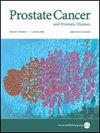评估基于血液和尿液的生物标志物,以检测具有临床意义的前列腺癌。
IF 5.1
2区 医学
Q1 ONCOLOGY
引用次数: 0
摘要
背景:由于认识到前列腺特异性抗原(PSA)筛查的局限性和前列腺活检的发病率,人们提出了几种基于血液和尿液的生物标记物,用于活检前的风险分层。这些检测方法旨在减少不必要的活检次数(即阴性或 1 级组 [GG1]),同时保持对有临床意义的癌症(GG≥ 2)前列腺癌的高灵敏度检测:我们回顾了目前可用的血液和尿液生物标记物用于检测 GG ≥ 2 癌症的文献,包括前列腺健康指数 (PHI)、4Kscore、MyProstateScore (MPS)、SelectMDx、ExoDx Prostate Intelliscore (EPI) 和 IsoPSA。为了便于临床应用,我们根据临床指南的建议,将生物标记物作为活检前的后PSA辅助检验。我们的研究结果包括检验性能指标--灵敏度、特异性、阴性预测值(NPV)和阳性预测值(PPV)--以及生物标记物的使用所带来的临床结果(即避免了不必要的活检、GG ≥ 2 癌症漏检):当代验证数据(2015-2023 年)显示,目前可用的生物标记物对 GG ≥ 2 PCa 的特异性约为 15-50%,灵敏度为 90-95%。在临床上,这表明对 PSA 升高的男性二次使用生物标志物检测可避免多达 15-50% 的不必要前列腺活检,同时保留 90-95% 的 GG ≥ 2 癌症的检出率,而这些癌症在传统的 "全部活检 "方法下是可以检出的:当代文献进一步支持了所提出的PSA后生物标志物检测的作用,即在保持高灵敏度检测GG≥2癌症的同时,减少侵入性活检的使用。关于生物标记物与 mpMRI 结合或依次进行的最佳应用仍存在疑问。本文章由计算机程序翻译,如有差异,请以英文原文为准。
Evaluation of blood and urine based biomarkers for detection of clinically-significant prostate cancer
Recognizing the limitations of prostate-specific antigen (PSA) screening and the morbidity of prostate biopsies, several blood- and urine-based biomarkers have been proposed for pre-biopsy risk stratification. These assays aim to reduce the frequency of unnecessary biopsies (i.e., negative or Grade Group 1 [GG1]) while maintaining highly sensitive detection of clinically significant cancer (GG ≥ 2) prostate cancer. We reviewed the literature describing the use of currently available blood- and urine-based biomarkers for detection of GG ≥ 2 cancer, including the Prostate Health Index (PHI), 4Kscore, MyProstateScore (MPS), SelectMDx, ExoDx Prostate Intelliscore (EPI), and IsoPSA. To facilitate clinical application, we focused on the use of biomarkers as a post-PSA secondary test prior to biopsy, as proposed in clinical guidelines. Our outcomes included test performance measures—sensitivity, specificity, negative predictive value (NPV), and positive predictive value (PPV)—as well as clinical outcomes resulting from biomarker use (i.e., unnecessary biopsies avoided, GG ≥ 2 cancers missed). Contemporary validation data (2015–2023) reveal that currently available biomarkers provide ~15–50% specificity at a sensitivity of 90–95% for GG ≥ 2 PCa. Clinically, this indicates that secondary use of biomarker testing in men with elevated PSA could allow for avoidance of up to 15–50% of unnecessary prostate biopsies, while preserving detection of 90–95% of GG ≥ 2 cancers that would be detected under the traditional “biopsy all” approach. The contemporary literature further supports the proposed role of post-PSA biomarker testing to reduce the use of invasive biopsy while maintaining highly sensitive detection of GG ≥ 2 cancer. Questions remain regarding the optimal application of biomarkers in combination or in sequence with mpMRI.
求助全文
通过发布文献求助,成功后即可免费获取论文全文。
去求助
来源期刊

Prostate Cancer and Prostatic Diseases
医学-泌尿学与肾脏学
CiteScore
10.00
自引率
6.20%
发文量
142
审稿时长
6-12 weeks
期刊介绍:
Prostate Cancer and Prostatic Diseases covers all aspects of prostatic diseases, in particular prostate cancer, the subject of intensive basic and clinical research world-wide. The journal also reports on exciting new developments being made in diagnosis, surgery, radiotherapy, drug discovery and medical management.
Prostate Cancer and Prostatic Diseases is of interest to surgeons, oncologists and clinicians treating patients and to those involved in research into diseases of the prostate. The journal covers the three main areas - prostate cancer, male LUTS and prostatitis.
Prostate Cancer and Prostatic Diseases publishes original research articles, reviews, topical comment and critical appraisals of scientific meetings and the latest books. The journal also contains a calendar of forthcoming scientific meetings. The Editors and a distinguished Editorial Board ensure that submitted articles receive fast and efficient attention and are refereed to the highest possible scientific standard. A fast track system is available for topical articles of particular significance.
 求助内容:
求助内容: 应助结果提醒方式:
应助结果提醒方式:


